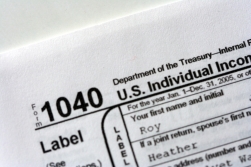 Do you think about taxes before you make investments? You should. Controlling your tax bill is easier when you think about taxes before you “buy”. What I’m talking about is tax efficient investing. Today, I’m going to discuss a basic level of tax efficient investing…selecting tax-efficient Mutual Funds and ETFs.
Do you think about taxes before you make investments? You should. Controlling your tax bill is easier when you think about taxes before you “buy”. What I’m talking about is tax efficient investing. Today, I’m going to discuss a basic level of tax efficient investing…selecting tax-efficient Mutual Funds and ETFs.
When you look at a Mutual Fund’s (or ETF’s) advertising materials you will normally see the fund’s returns. You will see the same or similar numbers on many “independent” fund ranking sites. But, what you’re not seeing is the after-tax return and the difference can be significant.
The reason comes down to how the fund earns its money. If a fund is actively managed, then normally there are more transactions and because of those transactions capital gains are recognized throughout the year. The capital gains will be distributed to the mutual fund shareholders in December and those distributions are taxable (assuming the funds are held in a taxable account). On the other hand, a passive/index fund will not have as many transactions and have lower capital gains to distribute in December.
So let’s take a look at a couple of examples. I’m not recommending any of these funds, but have selected them only to illustrate the point. We’ll look at some funds using on-year return as a determining factor (again, not recommending that you use one-year return as a determining factor but some do). Two asset classes that are illustrative are Large-Cap Blend and Small-Cap Value.
- Large Cap (Name of Fund/Return)
- Dreyfus Large Cap Equity Fund/27.36%
- Schwab US Large Cap ETF/24.77%
- Small Cap Value (Name of Fund/Return)
- Hotchkis & Wiley Small Cap Value Fund/32.06%
- Vanguard Small Cap Value ETF/28.23%
Using the returns above, you might be tempted to select the fund listed first. If you’re putting these funds in a taxable account, that might be a mistake. Let’s look at the same funds’ after-tax return (after tax returns are based on the highest tax bracket).
- Large Cap (Name of Fund/After-tax Return)
- Dreyfus Large Cap Equity Fund/19.89%
- Schwab US Large Cap ETF/23.77%
- Small Cap Value (Name of Fund/After-tax Return)
- Hotchkis & Wiley Small Cap Value Fund/22.04%
- Vanguard Small Cap Value ETF/27.20%
In both cases, the higher earning fund distributed more earnings (due to portfolio turnover) in December and as a consequence of the resulting taxes, their returns were reduced by almost 1/3 to below the after-tax return of the index ETFs.
What can you do about it? First ask your advisor if he/she considers tax efficiency when he/she builds your portfolio. If not, ask why and then ask yourself why he/she is your advisor. If you don’t have an advisor and don’t want one, information of funds’ tax efficiency is available through Morningstar.
Tax efficiency matters. There is a concept called “Tax Alpha” which basically describes the additional return that can be achieved through tax-efficient investing. Some studies put “Tax Alpha” at around 1-2%. Something to think about…
Curt Sheldon is an Independent Fee-only Financial Planner located in Alexandria VA with clients throughout the US.
He specializes in assisting transitioning Senior Military Officers reach their financial goals.

